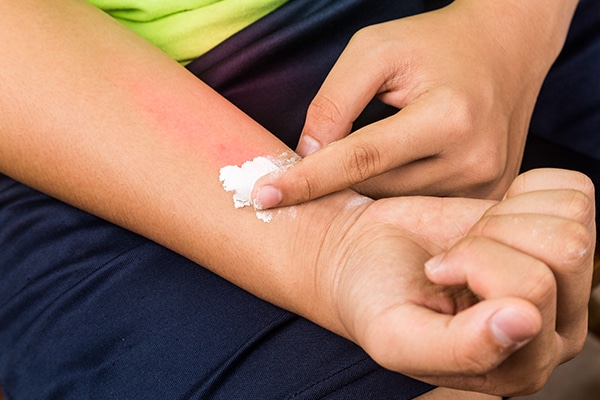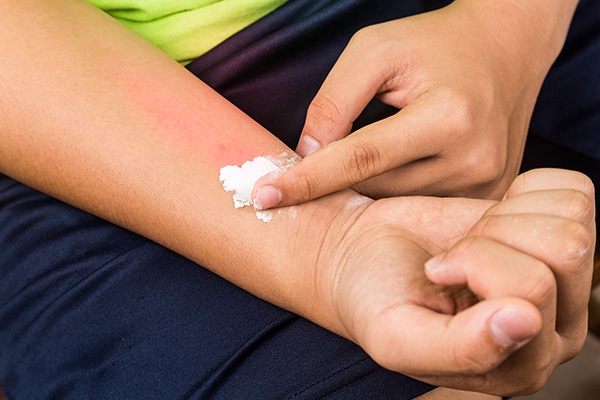Baking soda is an ingredient found in every kitchen, but it can be used for more than just cooking.
It is essentially a chemical compound called sodium bicarbonate, which is generally considered safe for oral and topical use in appropriate amounts but can still be irritating for some. (1)(2)
This article will discuss some lesser-known benefits of baking soda that can help improve your skin, hair, oral, and overall health.
Benefits of Baking Soda for Hair, Skin, and Body
Here are some ingenious ways to use baking soda for better health and hygiene:
1. Cleanses the hair and scalp
Anecdotal evidence suggests that baking soda may prove useful in deep cleansing your hair and scalp, but there is no scientific support for this claim except in one research paper. (3)
This granular ingredient may provide a gentle scrubbing effect to remove the oil, cellular debris, product residue, and other impurities settled within your hair follicles.
Scalp buildup can deprive your hair follicles of proper nutrition and ventilation, resulting in poor hair growth. Plus, it can act as fodder for germs that can trigger scalp infections to further ruin your hair health.
Baking soda may even help curb scalp inflammation due to its anti-inflammatory effects.
How to use:
- Take a teaspoon of baking soda in your palm and mix it with your shampoo.
- Gently massage this mixture all over your scalp and hair.
- Rinse thoroughly.
2. Can be used as a refreshing bath additive
Baking soda has an alkaline pH, which helps neutralize acids on the skin.
First, it breaks down the sweat, sebum, and dead skin cells accumulated on the surface of the skin. Then, gently massaging its tiny granules on the skin helps remove these impurities, unclogging your pores and making your skin soft, smooth, and bright.
Not just that, baking soda is deeply soothing for dry, itchy, swollen, or irritated skin, thanks to its potent anti-inflammatory activity.
How to use:
- Fill a bathtub with water.
- Sprinkle ½ cup of baking soda in your bathwater and give it a good stir.
- Soak in it for a while, and then gently scrub your skin with some baking soda granules.
- Take a shower with clean water to rinse the soda off your skin.
3. Helps in soothing irritated, itchy, and scaly skin

Chronic skin conditions such as eczema, dermatitis, psoriasis, ichthyosis, and rosacea are characterized by inflammation that manifests in the form of itchy, dry, scaly, red, irritated patches on different parts of the body. (4)
Baking soda is credited with strong anti-inflammatory properties that can help relieve these symptoms. (5)(6)(7)
Yet another common cause of skin rash is insect bites, and baking soda can prove useful in this regard as well. The sting releases venom under your skin that causes inflammation in the area. This inflammation leads to pain, swelling, itching, redness, and skin irritation.
Baking soda can help provide symptomatic relief by curbing the underlying inflammation. Plus, it may help draw out or neutralize the venom to some degree, which can also subdue the inflammatory skin reaction.
Note: Baking soda if used in large amounts can worsen skin irritation.
How to use:
4. Can be used as a mouth rinse
A solution of baking soda and water can serve as an effective mouthwash, according to recent research.
One 2020 study reported that this compound helps increase salivary pH when used in a mouth rinse and can make your oral cavity less hospitable for infection-causing germs. Thus, baking soda may help reduce the risk of oral diseases. (8)
How to use:
- Mix a teaspoon of baking soda in half a glass of water.
- Swish this solution in your mouth for 30–60 seconds and then spit it out.
- Rinse your mouth with plain water.
Note: A baking soda mouthwash should not be ingested.
5. Whitens yellow teeth
Baking soda helps dissolve and loosen the plaque and tartar collected on your teeth and works as a gentle scrub to remove them from the enamel. This deep-cleansing effect helps get rid of stubborn dental stains and makes your teeth visibly whiter over repeated use.
In fact, sodium bicarbonate is often added to whitening toothpaste as a hard abrasive mineral, which is more adept at removing dental stains than soft abrasives.
The downside of hard abrasives is that they can damage or erode the enamel if used too much, thereby exposing the sensitive inner layer called dentin. This can make your teeth weak and highly sensitive. (9)(10)
How to use:
- Put some baking soda directly on a damp toothbrush or after mixing it with your fluoride toothpaste.
- Brush your teeth with it.
- Rinse your mouth thoroughly.
Note: Be careful not to swallow the baking soda.
6. Treats nail fungus
Baking soda is known to exhibit antifungal activity against some of the most common culprits behind nail infections.
This was corroborated by a research study in 2013 that specified the effective concentrations for fighting different infection-causing fungi but did not expound on the mechanism of action. (11)
How to use:
- Mix a few drops of lukewarm water with a little bit of baking soda to make a paste.
- Apply it on top of your infected nail as well as under it.
- Let it sit for 10–15 minutes.
- Wash your feet/hands.
- Let the area air dry and then apply a moisturizer.
- Use this remedy several times a day, continuously for several days.
7. Relieves acid indigestion
Baking soda is commonly used as a safe, effective, and clinically approved antacid to alleviate gastric hyperacidity or acid indigestion. (12)(13)
It has a slightly alkaline pH, which neutralizes the excess acid in the stomach and thus provides quick digestive relief, but only when used in appropriate amounts and frequency.
How to use:
- Follow the instructions provided on the baking soda package.
- Generally, mix ½ teaspoon of baking soda in half a glass (4 fl. oz.) of water until it is completely dissolved. Drink this antacid solution every 24 hours, or as directed by your physician. Do not consume this amount more than once a day. (13)
Note: Excessive intake of baking soda can cause a sodium overload inside the body, which will inadvertently reduce the levels of other electrolytes such as calcium and potassium. This electrolyte imbalance may lead to fatigue, restlessness, vomiting, diarrhea, irritability, and even seizures.
So, stick with the recommended dosage and immediately consult your doctor if you experience any adverse symptoms. Plus, medicinal intake of baking soda is not safe for pregnant women. (14)
8. Reduces body odor
Regular perfumes and deodorants do not get rid of body odor but simply camouflage it with their strong fragrance. This effect tends to diminish over time and you start to smell like an odd mixture of scent and sweat.
Baking soda can help neutralize or get rid of body odor. It does so by dissolving the bacterial biofilm that forms on the sweaty parts of the body that is responsible for the foul smell.
Plus, it absorbs the sweat and moisture, thus limiting the growth of bacteria that cause body odor. (15)
How to use:
- Mix ⅛ teaspoon of baking soda with 1 tablespoon of water and a few drops of your preferred aromatic essential oil. Soak a cotton ball in the mixture, and dab it on your underarms and other sweaty areas.
- Sprinkle some dry baking soda on your underarms to soak up the sweat and minimize body odor throughout the day.
- You can also buy deodorants or antiperspirants that contain baking soda.
Note: Baking soda is highly alkaline in nature and may disrupt the skin’s natural pH.
Final Word
Baking soda, if used correctly and cautiously, can help improve your overall health and hygiene in different ways. This multipurpose ingredient costs next to nothing and is readily available but offers a range of benefits. So, don’t sleep on the healing potential of this handy remedy and make the most of it.

